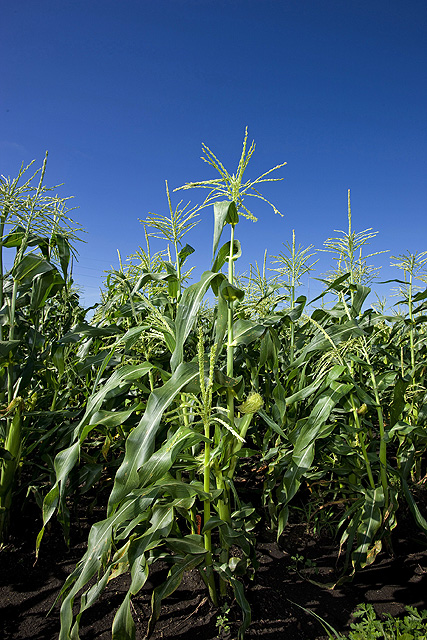Keeping Corn from Frequenting the Phosphorus Buffet Line
Contact: Jan Suszkiw
Email: Jan.Suszkiw@usda.gov
April 25, 2023
When it comes to food, plants can "eat" more than they need—just like the diner who can't resist another stop at the buffet line despite already feeling full. Indeed, with respect to phosphorus, corn plants will keep taking up the nutrient 25 to 80 percent beyond what's needed to reach their full grain yield, scientists with the Agricultural Research Service (ARS) in West Lafayette, Indiana, have found.
The corn plant's gluttonous appetite for phosphorus is known as "luxury consumption," and in extreme cases, it can decrease grain yields. Up until recently, though, corn's luxury consumption had only been demonstrated in studies with nitrogen and potassium. However, no direct links to phosphorous had yet been established, according to Chad Penn, a soil scientist with the ARS National Soil Erosion Laboratory in West Lafayette.
To investigate the matter, Penn and Purdue University graduate student Matt Wiethorn and Purdue agronomy professor James Camberato used a state-of-the-art "grow room" and hydroponics system. This enabled the researchers to precisely control the root environment of corn plants and the timing of phosphorous applications to them in pots filled with sand. More significantly, it allowed the researchers to monitor the bioavailability of phosphorous to corn plants more easily than growing them in field plots.
"This system demonstrated that it could produce corn that is the same as field-grown corn, both physically and chemically," noted Penn. "Developing it was a huge hurdle in being able to do this research on corn's luxury consumption of phosphorus," he added.
 When it comes to phosphorus, corn plants just can't say "No," scientists learn.
When it comes to phosphorus, corn plants just can't say "No," scientists learn.
The researchers began the study in 2019, using several corn hybrids, and published the results in the January 2023 issue of the journal Agronomy.
Among the study's findings, the corn hybrids needed an average of 580 milligrams of phosphorous per plant to reach their maximum grain yield. Beyond that, "excess phosphorus uptake caused a decrease in grain yield, which was attributed to reduced movement (translocation) of copper and zinc from the corn plant roots to grain," said Penn, whose team published a companion paper in Agronomy.
Penn noted that the research is a first step towards determining whether current phosphorus application recommendations can be refined based on what the corn plant actually needs for optimal yield and how much of the nutrient is already present in the soil (the type and condition of which can vary from one location to another)."Knowing the target phosphorous uptake value of 580 milligrams per plant can be used in developing more robust and precise soil phosphorus fertility recommendations in the future," he added. More broadly, such adjustments can contribute to natural resource sustainability since phosphorus fertilizers come from materials mined from finite geologic supplies in different parts of the world.
Penn's other research on nutrient management practices includes co-developing the P-trap, a software application that farmers and others can use to design, build and install in-field phosphorus removal systems to help reduce some of the "left-over" phosphorous that can escape the field as runoff and potentially compromise water quality.
The Agricultural Research Service is the U.S. Department of Agriculture's chief scientific in-house research agency. Daily, ARS focuses on solutions to agricultural problems affecting America. Each dollar invested in U.S. agricultural research results in $20 of economic impact.
